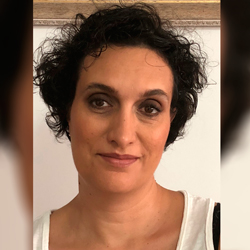100tífiques
4. Kaleidoscope
R&D&I Women’s Network: #100tífiques

Susaina Figuera, Head of Innovation, Catalan Foundation for Research and Innovation (FCRI)
Like all Catalan Foundation for Research and Innovation (FCRI) projects, which focus on socializing and disseminating the country’s science, the #100tífiques (a Catalan play on words meaning ‘100 women scientists’) project was launched in 2019. The FCRI had been creating and co-creating projects to encourage scientific and technical vocations in children and young people for years. This particular initiative sought to inspire primary and secondary school girls and young women by creating women role models in science through 100 simultaneous talks given by 100 women scientists at 100 schools across the country. In today’s post-pandemic setting, the number has almost quintupled.
But the project also had a dimension that was less immediately apparent: that of raising awareness amongst the women volunteers that they occupied their own specific shared space, of creating a network of ‘women in R&D&I’. The profile of our women scientists is not limited to research. It includes women researchers, innovators, technologists, engineers, executives at research-intensive businesses, science entrepreneurs, initiative promoters, policymakers, innovation managers, consultants and communicators. The richness of these interacting profiles is, thus, the FCRI’s firm commitment to transfer.
As such, the project is built on overlapping layers or different levels of transfer promotion. First, there is the contribution that these 100 women scientists make to society, transferring their expertise and the training they have received in higher education and within their organizations to the women scientists of tomorrow. Second, there is the potential transfer between them and their organizations. In this sense, we have strived to recruit women volunteers at universities and research centres, partnering with the Barcelona Institute of Science and Technology (BIST) for its ability to penetrate the country’s public system. But also to recruit women volunteers at companies such as Alcon, Allianz, AGBAR, BASF, B-Braun, Boehringer Ingelheim, HP, Lubrizol, Menarini, Provital or Werfen, in order to send a clear and powerful message: the best progress is built with the innovation that comes from the necessary collaboration between universities, research centres and companies. The system is, thus, an ecosystem of public actors and private organizations.
The stereotypes that limit children’s freedom to decide what they want to be when they grow up are related to sex, gender, social status, the alleged difficulty of a degree programme, scientific fields and professional development. But stereotypes about professionals in one field or another also loom up in the scientific community and at companies.
The stereotypes that limit children’s freedom to decide what they want to be when they grow up are related to sex, gender, social status, the alleged difficulty of a degree programme, scientific fields and professional development. But stereotypes about professionals in one field or another also loom up in the scientific community and at companies. The project, thus, aims to overcome the stereotypes of each successive layer: children, on the one hand; women scientists from the public and private sectors, on the other.
Once 50% of the country’s talent has chosen what they want to do without the constraints of these stereotypes, initiatives such as #100tífiques will no longer be needed. The set of initiatives in the country, which act locally across the territory, which seek to promote science, technology, engineering and mathematics (STEM) amongst students of all years and levels, which work with teachers, families and all manner of organizations, is also a powerful system that strives to transfer its project to society. #100tífiques has contained this third layer or level of transfer from the start as well. Once that happens, we said, then society will also have to include these women entering the ecosystem in key decision-making positions for the inclusion to be real. Women’s scientific and professional advancement to leadership positions must also reach 50%.
